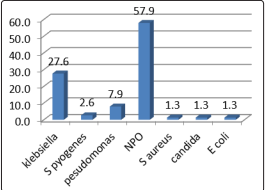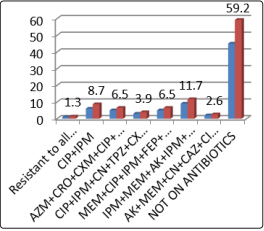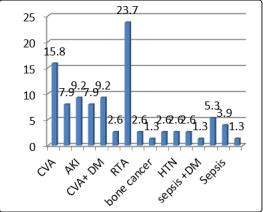Prevalence of Hospital Acquired Pneumonia in Intensive Care Units in Khartoum State (From April 2019 to September 2019)
© 2021 Amani Mohammed Ali Ahmed, Malaz Masaad Elsheikh Elkaki, Alsadig Kamal Elemam Albadri, Abdelhakam H Ali, et al. This is an open-access article distributed under the terms of the Creative Commons Attribution License, which permits unrestricted use, distribution, and reproduction in any medium, provided the original author and source are credited.
Abstract
Objectives: To determine the prevalence of nosocomial infections in intensive care unit (ICU), we performed a hospital?based study.
Materials and Methods: Consecutive patients were enrolled and details of risk factors and bacteriological data were obtained. Statistical analyses were performed using spss version 24.
Results: seventy six patients were admitted during the study period (minimum 10 years and maximum 91 years, men 69.7%, females 30.3%). Most important comorbidities were renal tubular acidosis (23.7%), cerebro vascular accidents (15.8%), and acute kidney injury (9.2%). Antibiotics were administered in 40.8%. Bacteriological cultures were positive in 42.1% (n=32). Gram negative bacteria were common–Klebsiella pneumoniae (27.6%), pseudomonas aerogenisa (7.95%), and Streptococcus pyogenes (2.6%) Escherichia coli (1.3%), Staphylococcus aurous (1.3%) and candida (1.3%). There a high prevalence of resistance to common antibiotics.
Conclusions: There is high prevalence of infections in patients in a medical ICU in Khartoum – Sudan. Gram negative bacteria are the most prevalent and resistance to antibiotics is high. Risk factors are age and multiple comorbidities.
Introduction
Pneumonia infections are one of the most important causes of
mortality in the world, more so in low and lower middle income
countries. Original burden of diseases study reported that although
the mortality due to pneumonia infections has decreased in the
last 30 years, they still remain an important cause of death and
persist as the most important cause of disability. Multiple factors
are responsible of pneumonia infection include rapid urbanization,
aging of the population and emerging viral and bacterial infections
combined with the age old upstream predisposing factors such as
poverty, inequality, and illiteracy [1-6].
Intensive care units (ICUs) are an important source of infections, especially bacterial infection. Studies in Europe and North America have reported that primary (at the time of admission) as well as secondary (nosocomial, ventilator associated, device related, and others) infections are common in ICUs. The European Studies on Prevalence of Infections in ICU (EPIC1 and EPIC2) reported a high prevalence of infections in a number of European countries High prevalence of infections, especially nosocomial, has also been reported from medical ICUs in the United States. This is associated with higher age and high prevalence of comorbid conditions [7-12]. Abd Elrahman etal , in 2016 conduct similar study in port sudan which revealed that; Two hundred specimens include (50 urine specimens, 50 wound swab, 20 Ear swab, 15 Throat swab, 25 Sputum, 10 Blood and 30 other specimens). Were collected from patients Suspected Hospital Acquired Infection through the study period from August 2015 to August 2016. Out of 200 patients 124 (62%) were positive, while 76 (38%) were negative, among the positive growth 34 (17%) of them were non lactose fermenter organisms, and 81 (40.5%) were lactose fermenter organisms while 9 (4.5%) organism?s dose not grow on Macconkey agar but shown significant growth with characters of beta hemolysis on Blood agar. The Gram reaction show that the Gram negative most frequent 85 (42.5%), Gram positive less frequent 39 (19.5%). The patients constitute 101 (50.5%) female and 89 (44.5%) male. The age of the patients ranged from less than 12years to more than 12years. Age more than 12 years are most frequent 181 (90.5%), while age less than 12 year rare less frequent 9 (4.5%).
The isolated Microorganism were as followed: Escherichia coli 33 (16.5%), S. aureus 21 (10.5%), Pseudomonas aeruginosa 20 (10%), Klebsiella pneumonia 17 (8.5%), Strepto Pyogene 9 (4.5%), Strepto faecalis 7 (3.5%) Out of 25 sputum specimens, 7 (28%) were shown positive culture while 18 (72%) shown negative culture. And the isolated organisms revealed as followed: Klebsiella pneumonia 6 (24%), Serratia spp 1 (4%). From 20 Ear swab specimen 12 (60%) were positive while 8 (40%) were negative. And the isolated organisms included pseudomonas aeruginosa 4 (20%), S. aureus 4 (20%), Klebsiella pneumonia 2 (10%), proteus vulgaris 1 (5%), E. coli 1 (5%). Out of 15throat swab specimen 9 (60%) were shown positive culture while 6 (40%) shown negative culture. The only isolated organism is Strepto pyogene. Out of 10 Blood specimen 4 (40%) were shown positive culture while 6 (60%) shown negative culture. And the isolated organisms are E. coli 1 (10%), Klebsiella pneumonia 1 (10%), pseudomonasauruginosa 1 (10%), Strepto faecalis 1 (10%). Out of 30other specimens 16 (53.3%) shown positive culture while 14 (46.7%) were shown negative culture. The isolated organisms revealed as followed: S. aureus 6 (20%), E. coli 4 (13.3%), Pseudomonas aeruginosa 2 (6.7%), S. epidermis?s 2 (6.7%), Klebsiella pneumonia 1 (3.3%), proteus mirabilis 1 (3.3%). All isolated organisms were subjected to antimicrobial sensitivity test using Kirby-Bauer disc diffusion method. Testing sensitivity of isolates to spectrum of antibiotic is a commonly used epidemiological tool. Standardized KirbyBauer disk gel diffusion testing provides useful guidance both to the clinician for appropriate therapy and to the epidemiologist as an in expensive screen for possible common identity of suspected organisms]13]. Sherifa m etal, in 2015 conducts study in altaief KSA which found that The 351 patients developing infection following hospital admission were included in this study. Of them, 170 (48.3%) had nosocomial infection and 181 (51.7%) had Here we presented an overall description of the community-acquired infection. Among those who system affected by infection and causative micro developed nosocomial infections, RTI were 55 (32.3%), organisms with further information on antibiotic UTI 43 (25.3%) and BI 31 (18.2%) respectively.
E. coli was the most prevalent exogenous. isolates from UTI 47.7%, followed by KP15.1% and PA8.1% In nosocomial pneumonia the commonest organism were KP 23.3% followed by CNS 16.7% and E COLI 15% Antimicrobial sensitivity pattern was studied for various organisms actionbacter species and MRSA were sensitive to imipentem(88.6%) and vancomycin 98.5% respectively E coli was sensitive to all antibiotics except ampicillin 26.6% ]1[.ml;0 Marcs, etal, in 2017conducted study in Intensive Care (EPIC II) in UK , Result of it showed that patients in intensive care units (ICUs) samples were as the following results: 137087 of796 patients (51%) were considered infected; 9084 (71%) were receiving antibiotics. The infection was of respiratory origin in 4503 (64%), and microbiological culture results were positive in 4947 (70%) of the infected patients; 62% of the positive isolates were gram- negative organisms, 47% were gram-positive, and 19% were fungi. Patients who had longer ICU stays prior to the study day had higher rates of infection, especially infections due to resistant staphylococci, Acinetobacter, Pseudomonas species, and Candida specie [15].
Considerable scientific interest and public health response.To determine prevalence of infections, demographic and clinical risk factors, bacteriological profile, drug sensitivity patterns, and determinants; we performed an epidemiological study in large hospitals in Khartoum- Sudan. This is one of the larger studies of ICU infections in Sudan with a focus on current patterns of bacteriological isolates at hospitals in Khartoum- Sudan. There are no previous data available from this part of the country [16-19].
The aim of this study therefore, was To Determine the prevalence of nose Comical pneumonia among ICU patients in Khartoum ,76 sample was collected involves (Sputum specimens, suction and endotracheal tube biopsy ) in sterile containers, after collected information by questioner. Screenings test should be done to detect carrier among hospital staff and Increase awareness about the hazards of using antibiotic for treatment without pre therapy culture and how bacteria gain resistant among people. Decreasing the costs of hospitalization, and final Decreasing the costs of hospitalization, and finally to Reduce the mortality and morbidity rates in These patients.
Materials and Methods
The study was performed at public and private hospitals in
Khartoum, Sudan. Protocol was approved by University ethics
committee. Consent was obtained from the hospital administration
and academic and research committee of the hospital for use of
anonym zed data of the patients. Individual patient consent was
also obtained. Consecutive patients admitted to the medical ICU
over 6 months from April 2019 to September 2019 were enrolled.
We obtained the details of demographic characteristics (age, gender, education, residence), clinical history, primary diagnosis, comorbidities, bacteriological profile, and risk factors. All patients in ICU whom developed signs and symptoms of pneumonia during 48 hours of admission to hospitals and during the study period were included. Those who developed signs and symptoms of pneumonia before 48 hours of admission and those who were
refused to participate were excluded.
The presence of the following comorbid conditions were noted: renal tubular acidosis, cerebrovascular accidents,diabetes mellitus, hypertension, coronary heart disease.In each patient admitted to the ICU, we obtained cultures of sputum or endotracheal secretions, and other relevant specimens were collected using standard procedures at admission and when indicated. Identification of the causative organisms was performed by standard microbiological methods. Organism identification and susceptibility testing was performed (monica, 2000).
Statistical analysis of all the data were computerized and entered into a database (Microsoft Excel) and analyses performed within this program. Descriptive statistics are reported. Numerical data are reported as mean ± 1 SD when variables were normally distributed .Categorical variables are reported as percent. P values less than 0.05 were considered significant.
Results
Seventy six patients were admitted during the study period (age
48.7 ± 21.9 yr, minimum 10yr and maximum 91 yr, men 69.7%,
females 30.3%). Most important comorbidities were renal tubular
acidosis (23.7%), cerebro vascular accidents (15.8%), and acute
kidney injury (9.2%).
Antibiotics were administered in 40.8%. Bacteriological cultures were positive in 42.1% (n=76).
Gram negative bacteria were common-Klebsiella pneumoniae (27.6%), pseudomonas (7.95%),S pyogenes (2.6%) Escherichia coli (1.3%), S auerueus (1.3%) and candida (1.3%). There a high prevalence of resistance to common antibiotics. Patients with positive cultures were older, (P = 0.03).
Bacteriological profile in infections is shown in Figure 1.
Gram-negative bacteria,
(Klebsiella and Pseudomonas) were the most prevalent organisms.

Figure 1: Isolated micro-organisms among study participants,n=76 Bacteriological drug sensitivity patterns revealed high prevalence of resistance to commonly use as well as third- and fourth-generation antibiotics (Figure 2).

Comorbid illnesses in subjects with or without bacteriological
isolation are shown in figure 3.

Figure 3: comorbid illnesses of the study participants, n=76 Significant proportions of patients with positive cultures were older p =0.03),
Discussion
This study shows that infections are common in a medical ICU
at a tertiary care hospital in Khartoum- Sudan. Bacterial isolation
with multiple organisms was observed. Risk factors for infections
are greater age, multiple comorbidities. Gram-negative bacteria
(Klebsiella, Escherichia, and Pseudomonas) are the most prevalent
and resistance to common antibiotics is high.
Critical care illnesses are a major problem in health care worldwide. The Global Burden of Critical Care Diseases study reported a high prevalence and mortality from such diseases, especially in low and middle income countries. ICU mortality in unselected patients in high. Hospital Acquired infections are associated with a great deal of morbidity, mortality and increased financial burden. Intensive care is a risk factor for the emergence of antibiotic resistant bacteria. Gram-negative bacteria have overtaken Gram- positive organisms as the predominant cause of Hospital Acquired infections. Inadequate antibiotic therapy is associated with poor outcome and particularly with bacterial resistance. Infection control measures are important for the effective control, prevention and treatment of infection. Knowledge of emerging pathogens and resistance profile is essential for treatment against Hospital.
Hospital-acquired infections have increased worldwide, contributing considerably to morbidity and mortality of the hospitalized patients Therefore, prolonging hospital stay can add significantly to the economic burden of underlying disease [20[.
In this descriptive hospital based study we tried to evaluate and detect the prevalence of nosocomial pneumonia among ICU patients.
the most common age among study participants was 65 years old and the rarest age was 10 years old, which agreed to abd alrahman ,etal where the most frequent age was > 12 years old rather than <12 years old Majority of patients (57.9%)show none pathogenic organisms during microbiological investigations while (42.1%) show positive organisms similar to abd alrahman ,etal where (72%) show none pathogenic organisms.The most common isolate was klebsiella (27.6%) in agreement with to abd alrahman ,etal where (24%) of the isolates was klebsiella.
Furthermore, In previous study pneumonia comprises approximately one-third of nosocomial infections in hospitals of Saudi Arabia. To reduce the incidence of NP,it is important to take into consideration the risk factors for NP that can be managed, and all those involved in hospital management need to set practical and effective guidelines for prevention of Hospital acquired infection [21-34].
References
1. Murray CJ, Lopez AD (1997) Global mortality, disability
and the contribution of risk factors: Global burden of disease
study. Lancet 349: 1436-42.
2. Lozano R, Naghavi M, Foreman K, Lim S, Shibuya K,
Aboyans V, et al. (2012) Global and regional mortality from
235 causes of death for 20 age groups in 1990 and 2010: A
systematic analysis for the global burden of disease study
2010. Lancet 380: 2095-2128.
3. Murray CJ, Vos T, Lozano R, Naghavi M, Flaxman AD,
Michaud C, et al. (2012) Disability-adjusted life years
(DALYs) for 291 diseases and injuries in 21 regions,
1990-2010: A systematic analysis for the Global Burden of
Disease Study 2010. Lancet 380: 2197-2223.
4. Leon D, Walt G (2001) Poverty, inequality and health: An
international perspective. Oxford: Oxford University Press
p 217-56.
5. Marmot M (2006) Health in an unequal world. Lancet 368:
2081-2094

